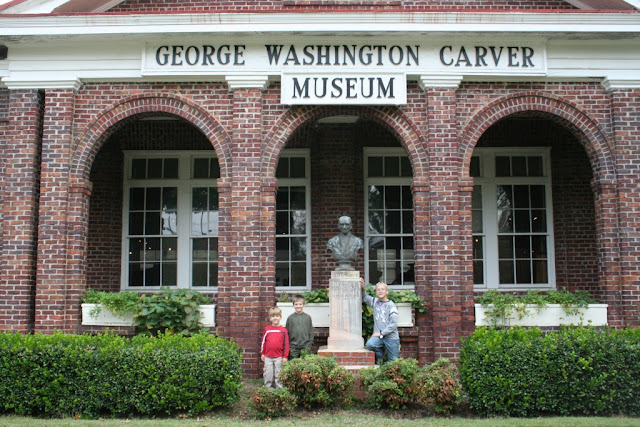As a boy he had a fascination with plants and animals. He grew his own flowers from cuttings and seeds. He wanted to go to school and did eventually despite the opposition and difficulties. He spent, I think, about twenty years completing his education, which was so very difficult for a black man at that time. The vast majority of schools did not allow for black students.
God provided though, and George became an amazing scientist. So much of what he knew though seemed so intuitive, pure wisdom and insight from God. What is more beautiful is that he was such a humble man who kept so little for himself. In 1896 he was invitated by Booker T. Washington to come and be the Director of Agriculture at Tuskegee College. He accepted this invitation and wanted more than anything to give back to the world more than he received from it. He didn't realize it, but his life's work was to be completed at and through Tuskegee University. Here are few neat things I learned about him:
1. He turned down multiple opportunities for jobs paying significant sums of money, including an invitation from Albert Einstein. His salary was 1500.00 dollars a year when he began at Tuskegee and he refused pay increases every year for the forty years he worked there. He often didn't even cash his checks and it wasn't uncommon for him to give his money to needy students. He wore the same plain clothing all his life.
2. He designed a school on wheels and took what he knew and gave it to the poor farmers in the countryside. You will see a picture of a more recent "school on wheels" below. He wanted more than anything to serve his fellow man, including those who hated him, the white man.
3. In one of the town's he was living in there lived another man named George Carver. To differintiate between himself and the other George Carver, he gave himself the middle initial W. Someone asked him, does that stand for Washington? George replied, "well, why not?" But he never,ever called himself or referred to himself as George Washington Carver. (George was the name given to him by his original "owners" and Carver was also their last name)
Okay, I've only scratched the surface of this humble genius's life. I encourage you to get a biography about him and read it!
Ever since we read the biography on George, I wanted to take the kids to the George Washington Carver Museum at Tuskegee University. It is only about an hour from Columbus, GA where my husband frequently travels for business. I was just waiting for the perfect trip for us to tag along with him on, which happened to be this week when Steve had 5 days in a row of business meetings in Columbus this week. That is very unusual and so I jumped at the chance! On Tuesday we headed to Tuskegee! It was so neat!
George, among so many other things, was a talented artist!
(I think he and Charlotte Mason were related!)
I love to see pictures of this man teaching, his great joy, in life!
He also worked to create medicines for the sick. He used peanut oil to treat a variety of conditions!
Here is a more recent example of the movable school on wheels.
During this time in Georgia history, cotton was widely grown as a cash crop. The farmers depended on it for their livelihood. The only problem was they didn't rotate their crops. George tried to warn them that they needed to give their land a chance to rest and plant other things that would give back to the soil, such as the peanut! Well, they listened, and harvest tons and tons of peanuts! The only problem was there was no market for peanuts! Farmers were angry at George! George went out in nature and prayed. Here is a quote from the Sower series biography of this particular conversation with God:
"Oh, Mr. Creator," I asked softly, "why did You make this universe?"
A wind stirred the trees a bit. "Your little mind asks too much," cam e the answer. "Ask something more your size."
Confused, I rubbed my chin. "What was man made for?" I whispered.
Once more, I seemed to hear a voice on the wind. "You are still asking too much, little man. Try once more."
I fell to my knees. "Dear Mr. Creator, why did You make the peanut?"
Once more the breezes rustled through the trees. "Now you are asking questions your own size. Together we will find the answers."
Here is the list of his discoveries!









No comments:
Post a Comment